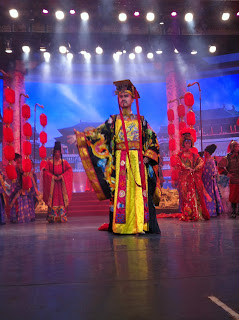At
lunch we had a noodle-making demonstration. You take wheat flour and
mix it with salty water, and knead it in flour. Then you hold the
two ends and swing it so that it stretches. You do this half a dozen
times and when it is sufficiently flexible you double it and then
swing and stretch it again. Repeating the process you have a dozen
or two dozen strands of noodle!
After
lunch we went to the Terracotta Warrior museum. There were the usual
hordes of people – many tour groups – but
because this place is so spread out it was possible to see things.
I know I am somewhat blasé about tourist sites, but even I have to
say that this one place is worth coming across the world to see. I
had seen pictures but the impact of the real thing is extraordinary.
A farmer was digging a well in 1974 when he unearthed the first piece
of what turned out to be 60 square kilometers of an extended buried
mausoleum for the first Qin emperor about 2200 years ago. The main
excavation area is huge – two and a half football fields long by
one football field wide. A single cantilevered roof covers all of it
with skylights for light. In the middle is the archeological field
divided into 15 or 20 areas. Each column of life-sized soldiers is divided by a thick
partition wall, at the top of which had been placed strong wooden
timbers for roofs. I could not believe I had forgotten to take my iPhone off the charger in the morning so I was without my camera, but here are some pictures from the Web.
It
is estimated that there are 8,000 figures there, every face and body
different and carved with a different live warrior serving as model.
The majority of the figures have not yet been excavated. When
originally found the figures were painted, but upon exposure to air
and light the paint oxidized and now they are sort of beige. The
faces are so realistic you might think they had just been sculpted
using people you see on the street every day as models.
The
warriors themselves remained living to serve the next emperor. Three
thousand concubines who did not have children were not so lucky:
they were buried alive, along with slaves and officials, to serve the
emperor in his next life. When the construction was done, a task of
forty years that required immense labor (Mike says a full third of China's
GDP at the time), the doors were sealed. The concubines who had
children were spared to take care of them.
Although
a few of the figures were found intact, the vast majority were in
pieces – imagine a huge three-dimensional jigsaw puzzle. The legs
were made of solid clay but the bodies were made of clay ropes coiled
around to form a chest, arms and head, and then sculpted for the
final details. They were therefore hollow. The timbers fell down
and crushed the warriors due to an insurrection against the Qin
dynasty which destroyed much of the mausoleum, the rotting and caving
in of the roof timbers over time, and an earthquake or two.
Archeologists will have their work cut out for them for many years,
sorting out the pieces and figuring out which go with which.
Although
most people in the group continue to eat huge meals three times a day
because the buffet breakfasts, lunches, and dinners have dozens of delicious dishes, give or take,
I have found that I am skipping some meals to be able to concentrate
on others. I am also no longer wanting seconds on anything, even if
the plate is the size of a saucer. However tonight we went to a
dinner theater of dance and acrobatics performances. Dinner consisted of rice wine, half a dozen
appetizers, eighteen different kinds of dumplings, soup, and three
desserts, literally. A feast like this shouldn't be skimped on and
it was a terrific experience, definitely worth skipping breakfast and
lunch for. The theater part was a show of Tang Dynasty (618-907 CE)
dances and acrobatic acts, with the most gorgeous, over-the-top costumes. I sat front and center (lucky me!) and there wasn't a shabby costume among them. Here are a lot of pictures, chosen from many more.
I
have learned to write some Chinese words!


















No comments:
Post a Comment